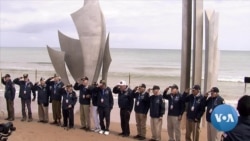As their wheelchairs reached the edge of the sand, the U.S. veterans struggled to their feet and walked onto Omaha Beach.
A group of visiting German soldiers were on hand to help the veterans with the final steps to the edge of the lapping waves — a touching image of a connection across generations and eight decades of history.
The scene played out Monday morning on this hallowed World War II battlefield, where 75 years earlier on June 6, 1944, some 34,250 U.S. troops were disembarked to begin the retaking of Nazi-occupied France. On that day alone, 2,499 U.S. soldiers were killed on Omaha Beach.
Russell Pickett, 94, was among the veterans revisiting the scene of that horrific battle Monday. On D-Day he was a 19-year-old private in the 116th Infantry Regiment, 29th Division. His task was to carry and operate a flame-thrower as his landing group came ashore. But he never got that far.
“Our folks hadn’t bombed their beach like they were supposed to, so we’d have some holes to get in [hide in], you know. So, we kind of came in like sitting ducks. I couldn’t stand up because I was afraid a bullet might hit the flamethrower. Our boat was blown to bits a few yards before we would have touched down. I woke up laying on the sand with my feet in the water. My legs wouldn’t work, so I don’t really know how I got in, but some way or another,” Pickett told VOA.
He was rescued by another landing craft, just as the tide was about to pull him out to sea. Pickett would face two more postings to the frontlines in Normandy.
“He had [picked up] about four more well-wounded. One had got his whole shoulder blown out, and he died on the way back to the ship. Next, they took me back to the ship and took me back to England, and by the time I got back to England, I could walk, you know, fairly well, hopping about on my right leg. And so, I came back with that same ship, and I was back with the unit in six days. I stayed with them then until we reached Saint-Lô," he recalled. " [The Germans] got me at Saint-Lô, and they carried me back to England again — 21 days that time — then I came back again. They put me up at Brest in the last part of September. That was two days before Brest gave up [the Germans surrendered]. They carried me out on a stretcher that time, so I couldn’t come back.”
Pickett was sent home to Tennessee in June 1945. He has suffered from post-traumatic stress disorder (PTSD) ever since D-Day, and struggles to hold back the emotion of returning to Omaha Beach.
“Believe it or not, I try to blank some of the thinking out. So, remembering all of my buddies that were killed and are buried in the cemetery up here. You can imagine, many friends. I can’t really explain how I feel. I’m glad I’m here, with this being my last trip,” he said.
Around thirty-five American D-day veterans have travelled to Normandy this year, many of them hosted by the Best Defense Foundation, which pays for the veterans and their families to make the trip through charitable donations. They are being joined by dozens of fellow veterans from Britain, Canada and other nations. All receive a hugely warm welcome at every stop.
But the joy and fascination among those they meet is tempered by the realization that these are the very last survivors of a heroic generation, and that one day soon, there will be no more veterans to pass on their vital stories of the horrors of war and the price of peace.
OMAHA BEACH, FRANCE —









